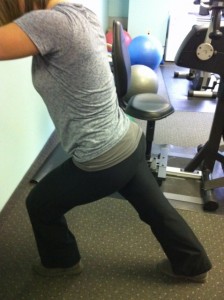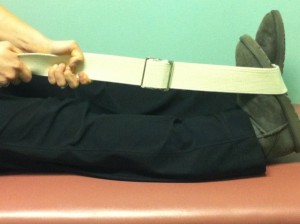There are many different opinions on the frequency and duration a person should exercise in a given week. Therefore, in 2007, The American College of Sports Medicine (ACSM) revised their guidelines for exercise to achieve a healthy lifestyle. These guidelines are good principles to think about when planning an exercise regimen. They are as follows:
<ol>
<li>Do fairly intense cardio 30 minutes a day, five days a week or do energetically intense cardio 20 minutes a day, 3 days a week.</li>
<li>Do eight to 10 strength-training exercises with 8 to 12 repetitions of each exercise twice a week.</li>
</ol>
<h3>Tips for following the guidelines:</h3>
Life gets busy so sometimes it is difficult to fit exercise into our schedules. Here are some tips to help include exercise into your life.
<ul>
<li>Mix it up:
<ul>
<li>To meet the guidelines, you can vary the cardiovascular exercise you perform. Such as, you can walk vigorously for 30 minutes twice a week, ride a bike at a moderate intensity for 20-30 minutes twice a week, and jog/run at a higher intensity one-two days a week.</li>
<li>Do it several times a day in shorter time frames:</li>
<li>If you are too busy to do 30 minutes of consecutive exercise, you can perform intense 10-minute bouts of exercise 3 times a day, equaling 30 minutes.</li>
</ul>
</li>
<li>Work out with friends/family:
<ul>
<li>To motivate you to continue your exercise routine, it is helpful to bring friends and family in on the fun! Therefore, you can motivate each other to continue exercising. It is also helpful to get involved in exercise classes. You will find that it is very motivating to have an instructor pushing you to make it through your workout class.</li>
</ul>
</li>
<li>Set your schedule:
<ul>
<li>Just like you schedule a meeting with work or friends, schedule exercise! By scheduling exercise, it helps you keep up with your routine and stay healthy.</li>
</ul>
</li>
<li>Starting an exercise program:
<ul>
<li>Some people find starting an exercise program very intimidating. If you fall in this category, there are some options out there for you. Harbor Physical Therapy offers <span style=”text-decoration: underline;”><strong>wellness evaluation</strong></span>. This entails a session with Dr. Amanda working on whatever aspect of your body you feel needs expert attention. Dr. Amanda can provide you with a workout regimen that gets you started on your healthy lifestyle. Also, if you get bored with your routine or want to try something different, Dr. Amanda can continue providing you guidance. <strong>Please give us a call at 443-524-0442 for details.</strong></li>
There are many different opinions on the frequency and duration a person should exercise in a given week. Therefore, in 2007, The American College of Sports Medicine (ACSM) revised their guidelines for exercise to achieve a healthy lifestyle. These guidelines are good principles to think about when planning an exercise regimen. They are as follows:
- Do fairly intense cardio 30 minutes a day, five days a week or do energetically intense cardio 20 minutes a day, 3 days a week.
- Do eight to 10 strength-training exercises with 8 to 12 repetitions of each exercise twice a week.
Tips for following the guidelines:
Life gets busy so sometimes it is difficult to fit exercise into our schedules. Here are some tips to help include exercise into your life.
Mix it up:
- To meet the guidelines, you can vary the cardiovascular exercise you perform. Such as, you can walk vigorously for 30 minutes twice a week, ride a bike at a moderate intensity for 20-30 minutes twice a week, and jog/run at a higher intensity one-two days a week.
Do it several tmes a day in shorter time frames:
- If you are too busy to do 30 minutes of consecutive exercise, you can perform intense 10-minute bouts of exercise 3 times a day, equaling 30 minutes.
Work out with friends/family:
- To motivate you to continue your exercise routine, it is helpful to bring friends and family in on the fun! Therefore, you can motivate each other to continue exercising. It is also helpful to get involved in exercise classes. You will find that it is very motivating to have an instructor pushing you to make it through your workout class.
Set your schedule:
- Just like you schedule a meeting with work or friends, schedule exercise! By scheduling exercise, it helps you keep up with your routine and stay healthy.
Starting an exercise program:
- Some people find starting an exercise program very intimidating. If you fall in this category, there are some options out there for you. Harbor Physical Therapy offers wellness evaluation. This entails a session with Dr. Amanda working on whatever aspect of your body you feel needs expert attention. Dr. Amanda can provide you with a workout regimen that gets you started on your healthy lifestyle. Also, if you get bored with your routine or want to try something different, Dr. Amanda can continue providing you guidance. Please give us a call at 443-524-0442 for details.



